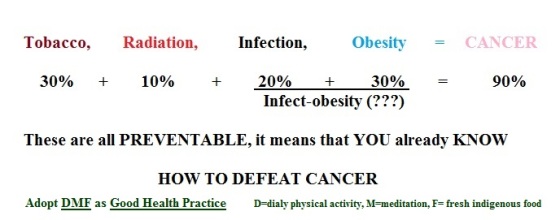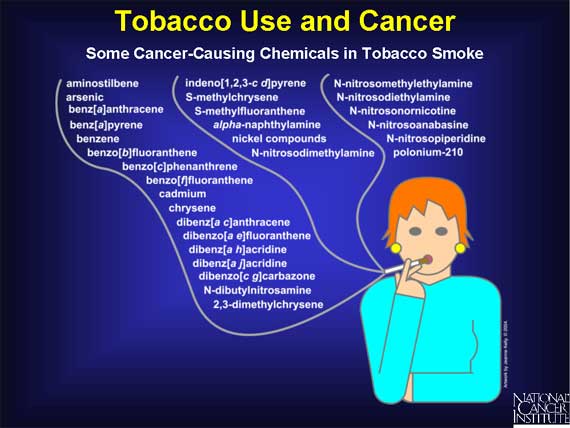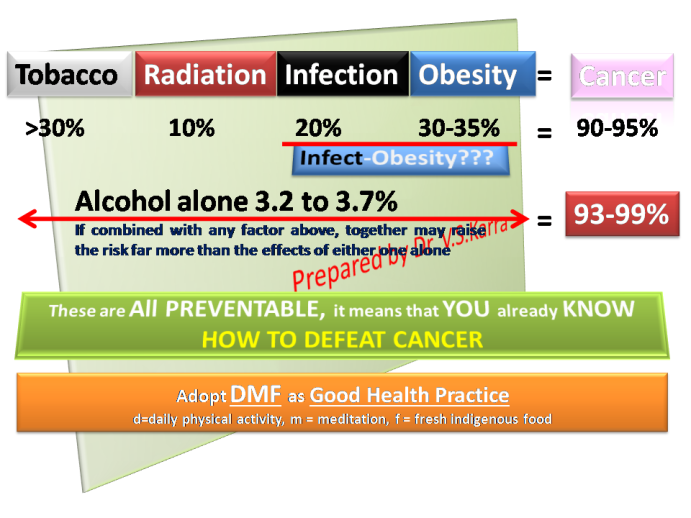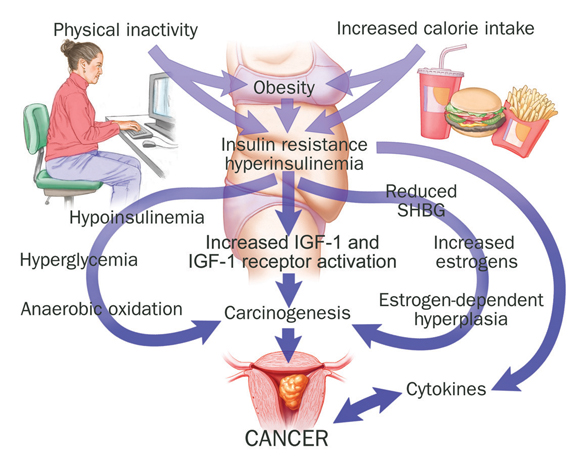There are more than 100 types of Cancers. To learn about them go to: cancer.org.
It appears that there is not much to panic, because the matter of the fact is that if we look at what causes cancer, it is very obvious that majority of the cancers are preventable.
Look at WHAT CAUSES CANCER
- Inherited (Hereditary) – about 5-10%
- Acquired (sporadic/ somatic) during their life time
- Environmental (90-95% of cases) factors e.g.,
- Tobacco (at least 30%) – about 87% of the lung cancers are due to tobacco habit. Tobacco-Cancer Fact Sheet
- Infections (15-20%)
- Radiation (both ionizing and non-ionizing, up to 10%)
- Obesity (30-35%) and
- Pollutants, Sedentary life, poor diet etc.,
- Environmental (90-95% of cases) factors e.g.,
These environmental factors can directly damage genes or combine with existing genetic faults within cells to cause the disease.
You know that there are two types of genes (remember these two genes while reading the following):
* Oncogenes: It can cause cancer (this happens when pro-oncogenes mutate and get activated or turned on).
* Tumor suppressor genes – it controls cell division, repair DNA mistakes and cell death (called apoptosis or programmed cell death). It stops cancer from developing or growing, but it can also cause cancer if they are inactivated or turned off.
1. Hereditary (about 5-10%): cancer.org
American Cancer Society suggests that: Cancer is such a common disease that it is no surprise that many families have at least a few members who have had cancer. Sometimes, certain types of cancer seem to run in some families. This can be caused by a number of factors. It can be because family members have certain risk factors in common, such as SMOKING, which can cause many types of cancer. It can also be due in part to some other factors, like OBESITY, that tend to run in families and influence cancer risk.
But in some cases the cancer is caused by an abnormal gene that is being passed along from generation to generation. Although this is often referred to as INHERITED cancer, what is inherited is THE ABNORMAL GENE that can lead to cancer, NOT THE CANCER ITSELF. Only about 5% to 10% of all cancers are inherited – resulting directly from gene defects (called mutations) inherited from a parent.
Please note that when many cases of cancer occur in a family, it is most often due to chance or because family members have been exposed to a common toxin, such as CIGARETTE SMOKING (again it was an exposure to environmental factors at some point in the family tree).
Less often, these cancers may be caused by an inherited gene mutation. (These are called family cancer syndromes.) Certain things make it more likely that an abnormal gene is causing cancers in a family, such as
- Many cases of an uncommon or rare type of cancer (like kidney cancer)
- Cancers occurring at younger ages than usual (like colon cancer in a 20 year old)
- More than one type of cancer in a single person (like a woman with both breast and ovarian cancer)
- Cancers occurring in both of a pair of organs (both eyes, both kidneys, both breasts)
- More than one childhood cancer in a set of siblings (like sarcoma in both a brother and a sister)
Therefore, one must gather some information if you decide that cancer runs in your family.
For each case of cancer, look at:
- Who is affected? How are we related?
- What type of cancer is it? Is it rare?
- How old was this relative when they were diagnosed?
- Did this person get more than one type of cancer?
- Did they smoke or have other known risk factors?
2. Acquired (Sporadic/ somatic): 90-95% of cases…
-
Tobacco (at least 30%): if you wish you can quit Tobacco consumption today itself (it is never late) – do this good favor to yourself and to your neighbors. In fact by doing so, you are already contributing to the welfare of the society – a great service to the passive-smokers or non-smokers exposed to secondhand smoke (SHS) or environmental tobacco smoke(ETS) – in return, you will get respect and will save lots of money, health of your loved-ones and your health too. Here is the data by region on second-hand smoke exposure . It clearly illustrates that up to 60% women and up to 60% men aged above 15 years are exposed to second-hand smoke, and also most importantly up to 70% of children under 15 years of age are exposed to second-hand smoke. Data on mortality and burden of disease from Second-hand smoke suggests that second-hand smoke is causing Respiratory diseases, Ischemic heart disease and Cancer. All that can be prevented if you stop smoking today.
You know that tobacco smoke contains more than 7,000 chemical compounds and at least 69 of them are known to cause cancer. Smoking and drinking alcohol together raises the risk far more than the effects of either drinking or smoking alone. You already know that alcohol is a known cause of cancers of, for example, mouth, throat (pharynx), voice box (larynx), esophagus, liver, colon & rectum, breast, and moreover, the risk increases with the amount of alcohol consumed. One recent study suggests that 3.2% to 3.7% of all cancer deaths in US are attributable to alcohol consumption and suggests that reducing alcohol consumption is an important and underemphasized cancer prevention strategy. Therefore, quitting smoking and alcohol altogether is a good idea. To learn more on this – mechanism, role of genes etc., – click here
It also means that the above mentioned pictorial statistics can be modified and presented as below:
Smoking prevention and cessation should continue to be the focus of public health efforts to reduce lung cancer incidence and mortality, says one study-http://www.ncbi.nlm.nih.gov/pmc/articles/PMC3044470/. It further adds that “Quitting smoking clearly reduces the risk of developing any type of lung cancer, compared with continuing.”

Quitting smoking is a BIG DEAL! So make an effort from today or when you are ready to do so, get inspired and inspire others to quit (But when you are ready to help others, just follow these valuable tips: Helping a Smoker Quit: Do’s and Don’ts).
Recent study (June 25, 2013) published in PNAS suggests that “Brief meditation training improves self-control capacity and reduces smoking“
- Radiation (about 10%): minimize exposure to radiation where possible. Don’t worry about the things which are beyond our control, but make an effort to avoid where it is possible to avoid.
From highest to lowest energy, the main forms of radiation are:
- Gamma rays
- X-rays
- Ultraviolet (UV) rays
- Visible light
- Infrared rays
- Microwaves
- Radiofrequency (radio) waves
- Extremely low-frequency (ELF) radiation
Health risk depends on whether the radiation frequency is high (Ionizing) or low (non-ionizing). High-frequency radiation (e.g., Gamma rays, x-rays, some high-energy UV rays) that has enough energy can damage the DNA in cells, which in turn may lead to cancer. Whereas, low-frequency radiation that does not have enough energy are not known to increase cancer risk.
- Infections (about 20%): this can be prevented by maintaining proper hygienic conditions and can be controlled immediately with the available antibiotics and can be prevented probably more preferably by timely recommended vaccinations due to the recent developments in our understanding on the antibiotic resistance. In many cases, infection-related cancer is preventable. International Agency for Research on Cancer in Lyon, France, reviewed data for 27 different types of cancer in 184 countries. They found that about 16% of all cancer cases worldwide are related to infection, most of it in developing countries. According to the study, 80% of infection-related cancer occurs in less developed regions. The study was published online May 9, 1012 in The Lancet Oncology. Two prevalent cancer-causing viruses are human papillomavirus (HPV) and hepatitis-B virus (HBV). It is important to note that around 30% of infection-attributable cases occur in people younger than 50 years.
- Obesity (about 30%): body weight seems to have the strongest evidence linking it to cancer. An estimated 1 out of every 3 cancer deaths in the United States is linked to excess body weight, poor nutrition, and/or physical inactivity, and excess body weight contributes to as many as 1 out of 5 of all cancer-related deaths.
Being overweight or obese is clearly linked with an increased risk of many cancers, including cancers of the:
- Breast (in women past menopause)
- Colon and rectum
- Endometrium (lining of the uterus)
- Esophagus
- Kidney
- Pancreas
Being overweight or obese also likely raises the risk of other cancers, such as: Gallbladder, Liver, Non-Hodgkin lymphoma, Multiple myeloma, Cervix, Ovary and Aggressive forms of prostate cancer.
Excess body fat might affect the following and may lead to certain cancer types:
- Immune system function and inflammation
- Levels of certain hormones, such as insulin and estrogen
- Factors that regulate cell division, such as insulin-like growth factor-1 (IGF-1)
- Proteins that influence how the body uses certain hormones, such as sex hormone-binding globulin
“Alcohol can add extra calories to the diet, which can contribute to weight gain in some people. So please be aware of the fact that alcohol use can also increase the risk in one way or another.”
“Obesity and other diet related factors can be controlled with little effort, i.e., Daily physical activity, Meditation (proper, rhythmic breathing exercises etc.) Fresh Indigenous Food., therefore adopt DMF as a Good Health Practice.”
Research studies at Mayo Clinic suggest that older age, male sex, obesity, diminished physical activity, a diet high in calories and glycemic index, excessive alcohol intake, and tobacco smoking are associated with increased risk of diabetes, as well as many cancers. “Large cohort studies show that pancreatic, colorectal, breast, hepatobiliary, bladder, and endometrial cancers occur more frequently in people with type 2 diabetes. Potential reasons behind this association include common causality (shared risk factors), hyperglycemia, and other metabolic abnormalities of type 2 diabetes that cause cancer, and cancer that causes hyperglycemia.”
“A common thread for many of these risk factors is hyperinsulinemia. Insulin induces cell proliferation. Hyperinsulinemia, insulin resistance, and obesity are associated with increased estrogens, endometrial hyperplasia, and breast and endometrial cancers. “Obesity is also associated with increased insulinlike growth factor 1 (IGF-1) activity due to reduced levels of insulinlike growth factor binding proteins 1 and 2. Most malignant cells express IGF-1 receptors. Activation of IGF-1 receptors by IGF-1 or insulin, or both, is thought to have an important role in carcinogenesis.
Infect-obesity (infections that contribute to human obesity): There appears to be an increasing interest to understanding the etiology of obesity due to rapid increase in obesity. Of the several etiological factors, infection has recently started receiving greater attention. In the last two decades, 10 adipogenic pathogens were reported, including human and nonhuman viruses, scrapie agents, bacteria, and gut microflora. Some of these pathogens are associated with human obesity says one study (2007). http://www.ncbi.nlm.nih.gov/pubmed/17425944
Recent review (2011) on Infect-obesity says that ”a comprehensive understanding of the causative factors of obesity might provide more effective management approaches”. http://www.ncbi.nlm.nih.gov/pubmed/22115071
Another study (2012) reviewed the literature concerning the role of adenovirus 36 (AD-36) which says that AD-36 is the most widely studied infectious agent in animals and humans, because of its potential association with childhood obesity. The available evidence suggests that more studies are needed to evaluate whether or not the association between the presence of AD-36 antibodies and obesity is simply unrelated, and to verify whether there are subjects that have greater tendency to become obese because more easily susceptible to AD-36 infection or with a predisposition to suffer from persistent viral infection more easily leading to the development of obesity.
If it is demonstrated that AD-36 does play a role in obesity, it will be important to investigate possible vaccines against the infection itself or antiviral drugs capable of inhibiting disease progression. http://www.ncbi.nlm.nih.gov/pubmed/22771001
Study (2012) by Korean scientists suggests that Ad-36 seems to be strongly associated with overweight, but not obese, Korean adults. http://www.ncbi.nlm.nih.gov/pubmed/21587203
Interestingly, as you could see most of the cancers, including some of the hereditary or inherited cancers are triggered by most of the environmental influences which, I strongly believe, are preventable.
Lets Make an Effort to Prevent the Preventable
The following beautifully presented diagram shows the results of new research funded by Cancer Research UK, which aims to show the number of cancer cases in the UK that could be prevented by known lifestyle and environmental factors.
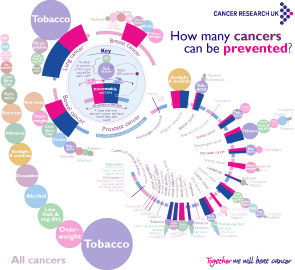
Results of new research funded by Cancer Research UK, suggest that the number of cancer cases could be prevented by known lifestyle and environmental factors
Although much is known about the impact of single factors, the current evidence about the combined effects of lifestyle behaviors on mortality has not yet been systematically compiled. The recent study published in PrevMed suggests that “The relative risks decreased proportionate to a higher number of healthy lifestyle factors for all cause mortality. A combination of at least four healthy lifestyle factors is associated with a reduction of the all cause mortality risk by 66%.
While addressing the above facts in preventing Cancer and other related diseases, we are relentlessly working to focus with great emphasis on young people, who are in their puberty and adolescence. Because these kids are the future of the healthy world and preventive measures at/ from this age is likely to yield an absolutely healthy world. One very recent article (2011) clearly supporting our idea/ mission and details of their study are as follows:
1. Global burden of disease in young people aged 10-24 years: a systematic analysis: Young people aged 10-24 years represent 27% of the world’s population – the population, the future of the healthy world. This study described the global burden of disease arising in young people and the contribution of risk factors to that burden. The study concludes that the total number of incident Cause-specific disability-adjusted life-years (DALYs) in those aged 10-24 years was about 236 million, representing 15·5% of total DALYs for all age groups. Africa had the highest rate of DALYs for this age group, which was 2·5 times greater than in high-income countries (208 vs 82 DALYs per 1000 population). Across regions, DALY rates were 12% higher in girls than in boys between 15 and 19 years (137 vs 153). Worldwide, the three main causes of years lost because of disability (YLDs) for 10-24-year-olds were neuropsychiatric disorders (45%), unintentional injuries (12%), and infectious and parasitic diseases (10%). The main risk factors for incident DALYs in 10-24-year-olds were alcohol (7% of DALYs), unsafe sex (4%), iron deficiency (3%), lack of contraception (2%), and illicit drug use (2%).
Opportunities for prevention of disease and injury in this age group are not only not fully exploited but also largely neglected in global public health. The fundamental reason could be because this age group is perceived as healthy.
2. Another Study on Global burden of human food-borne diseases: e.g., trematodiasis – these are a group of neglected tropical diseases caused by liver, lung, and intestinal parasitic fluke infections. On the basis of available information on pathological and clinical appearance, they developed simplified disease models and did meta-analyses on the proportions and odds ratios of specified sequelae and estimated the global burden of human food-borne trematodiasis. This meta-analyses suggests that about 56·2 million people were infected with food-borne trematodes in 2005: 7·9 million had severe sequelae and 7158 died, most from cholangiocarcinoma and cerebral infection. Taken together, it was estimated that the global burden of food-borne trematodiasis was 665,352 DALYs (lower estimate 479,496 DALYs; upper estimate 859,051 DALYs).
What is your observation, studies and evidences?
Your INPUT MATTERS.
Share with us.
(updated regularly)
Note: You too can add relevant info, but in a simple text…. please send your input to:
Related Articles:
ACS Guidelines on Nutrition and Physical Activity for Cancer Prevention
Sleep Apnea Tied to Increased Cancer Risk: “This is really big news,” said Dr. Joseph Golish, a professor of sleep medicine with the MetroHealth System in Cleveland. “It’s the first time this has been shown, and it looks like a very solid association,” he said. Researchers in Spain followed thousands of patients at sleep clinics and found that those with the most severe forms of sleep apnea had a 65 percent greater risk of developing cancer of any kind. The second study, of about 1,500 government workers in Wisconsin, showed that those with the most breathing abnormalities at night had five times the rate of dying from cancer as people without the sleep disorder. Another study found that the greater the extent of hypoxemia, or oxygen depletion, during sleep, the more likely a person would receive a cancer diagnosis during the study period.
TGI: Health is mother of all prosperity
TGI: Cancer
TGI: Explore the associations between food and nutrient intake, personality traits and resilience
TGI: Stress can alter the biology of the brain, and tip a mind into illness
Healthy living ‘can add 14 years’ – European Prospective Investigation of Cancer (EPIC)
Actual Causes of Death: This study concludes that smoking remains the leading cause of mortality. However, poor diet and physical inactivity may soon overtake tobacco as the leading cause of death.
Measuring the global burden of disease and epidemiological transitions: 2002-2030.: Projections to 2030 indicate that, although the major vascular diseases will remain leading causes of global disease burden, with HIV/AIDS the leading cause, diarrheal diseases and lower respiratory infections will be outranked by Chronic Obstructive Pulmonary Diseases, in part reflecting the projected increases in death and disability from tobacco use.
Global and regional causes of death: It says that “One-half of all child deaths are from four preventable and treatable communicable diseases –
-
Ischaemic heart disease,
-
Cerebrovascular disease,
-
Lower respiratory infections,
-
Chronic obstructive pulmonary disease, and the others are,
-
Diarrheal diseases,
-
AIDS,
-
TB.
Globally, around 6 in 10 deaths are from non-communicable diseases, 3 from communicable diseases and 1 from injuries.” Also, Nine of 10 deaths in 2004 occurred in low- and middle-income countries, reinforcing the fundamental importance of improving mortality statistics as a measure of health status in the developing world.
Socio-economic inequalities in childhood mortality in low- and middle-income countries: a review of the international evidence: Childhood mortality is systematically and considerably higher among lower socio-economic groups within countries. Also most proximate mortality determinants, including malnutrition, exposure to infections, maternal characteristics and health care use show worse levels among more deprived groups. The magnitude of inequality varies between countries and over time, suggesting its amenability to intervention. Reducing inequalities in childhood mortality would substantially contribute to improving population health and reaching the Millennium Development Goals (MDGs).
Selected major risk factors and global and regional burden of disease:
In the poorest regions of the world, childhood and maternal underweight, unsafe sex, unsafe water, sanitation, and hygiene, indoor smoke from solid fuels, and various micronutrient deficiencies were major contributors to loss of healthy life. In both developing and developed regions, alcohol, tobacco, high blood pressure, and high cholesterol were major causes of disease burden.
Michael Blaha, MD, MPH, Director of Clinical Research at the Johns Hopkins Ciccarone Center for the Prevention of Heart Disease, says that there is little doubt that diet shifts in the last 20 to 30 years have directly contributed to the current epidemic of obesity, metabolic syndrome, and diabetes. The message about what to eat needs to be more nuanced. It is probably inappropriate to single out a single macronutrient as harmful. He says, “The message should be to eat more fresh foods and less pre-packaged and pre-prepared foods“. In the same post, Carl Lavie, MD, Medical Director of Cardiac Rehabilitation and Prevention at the John Ochsner Heart and Vascular Institute rightly said that in a society where energy expenditure — including household management and occupational physical activity — has markedly fallen during the past 5 decades, coupled with failure to make up for this with increased leisure-time physical activity, high-carbohydrate diets may be increasing insulin resistance and many of its consequences (whereas with high physical activity, eating sugars and complex carbohydrates would not be so detrimental). Ideally, without very high levels of physical activity, many would be better off with lower carbohydrate intakes, and higher fat intake — probably of omega-3 fatty acids (fish oils) and omega-9 fatty acids (monounsaturated fats such as oleic acid or olive oil) — would be ideal. But even so, saturated fats may be better than super high levels of carbohydrates. Saturated fats and cholesterol are safer than the trans fats.
Dr. David Katz, Director, Yale Prevention Research Center says “Diet never was, and never will be, a single ingredient enterprise. The whole recipe matters“.
The secret of Health may be lying in the “dietary pattern and lifestyle pattern”
Acknowledgements:
TGI acknowledges Dr. Simon John Clark, Head of Clinical Performance at Cadence Performance Ltd, for his invaluable suggestions on alcohol consumption vs cancer risk. The same with the recent results was incorporated in the post. To read the full comments, please visit LinkedIn: Philips-Innovations In Health, post: You Already Know How to Defeat Cancer
